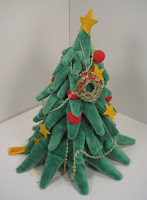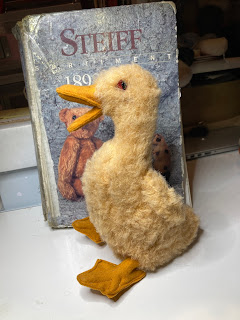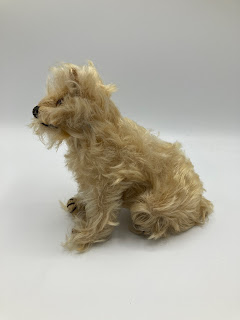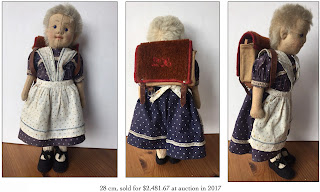Given how adorable and appealing Steiff's dolls, bears, and animals are, it is no surprise that antique advertising featuring these photogenic superstars can be as collectible as the items themselves. Early Steiff catalogs, mailers, and advertisements give unique insights into the design and marketing priorities of the company over time. They can also provide interesting metrics like prices, weights, and minimum orders, and even company or distributors' names, addresses, and contact information.

Check out this amazing piece of ephemera featuring Steiff's legacy Jocko chimpanzees. There is much to learn from this simple 3" x 5" card. This all original example was produced around 1912 for Steiff's business partner in Paris. The front of this double sided, cardboard card shows a full color image of six Jockos playing in a miniature bedroom. The space is furnished with three wooden chairs and a bed. There is also a framed and matted picture on the wall. Three Jockos don turn of last century style dresses detailed with pleated fronts and decorative embroidery. Two others wear blue playsuits with white trim. And one is just simply in his birthday suit. The Jocko on the far right seems upset, and her friend just to her left appears worried about that. Steiff always had a great way of capturing these emotional subtleties in their early images. You can also see Steiff branding on the top left side of the image. The vignette is simply irresistible.
The back of this time capsule is equally as interesting, but for different reasons. It has a simply rendered map of turn of last century Paris, with a red square indicating the location of the Steiff distributorship at 23 Rue des Petites-Hotels. The words on the card summarize as: "Fabric Toy Factory, Margarete Steiff, located at 23 Rue des Petits Hotels in Paris with the head office in Giengen on the Brenz River in Germany. Offering toys and animals, dolls, kites, and pincushions made from felt, plush, velvet, etc. Winner of the grand prize at the World's fairs in Saint Louis in 1904 and Brussels in 1910."
The actual intended purpose of this card is not clear. It doesn't have a space for an address or stamp, so it could not be mailed like a postcard as we know them today. And it is a little large for a standard business card. It might have been put in an envelope as a mailer, or it could have been handed out at a trade show or exhibition as a mini brochure. The map on the back suggests that the location may have been hard to find, and/or that the location encouraged visitors.
A simple google search finds that today, 23 Rue des Petites-Hotels in Paris is occupied in part by the Al Dente Agency. According to their website, Al Dente describes itself as: “We are an integrated creative agency based in Paris and Rome, believing in the cultural aura of luxury brands.” Perhaps its principals could feel the Steiff love - and aura - when they considered this location for their business in the City of Lights? Above you can see what the street looks like today from the on-the-ground perspective; the image is from Wikipedia.org.
Steiffgal hopes this discussion on this Jocko card has given you a little insight into the company's turn of last century monkey business.
Have a question about one of your Steiff treasures? Let's talk! Click here to learn more.























































